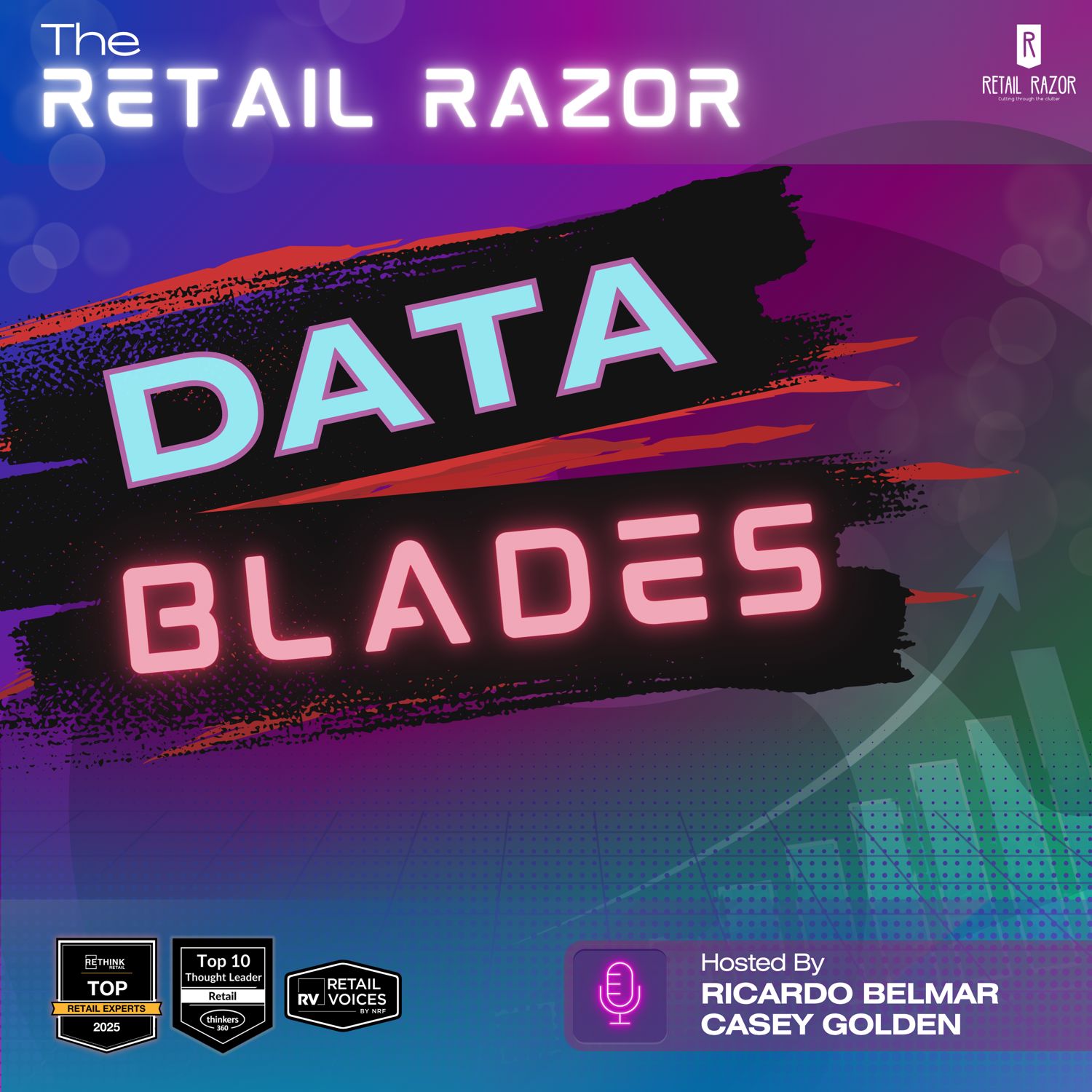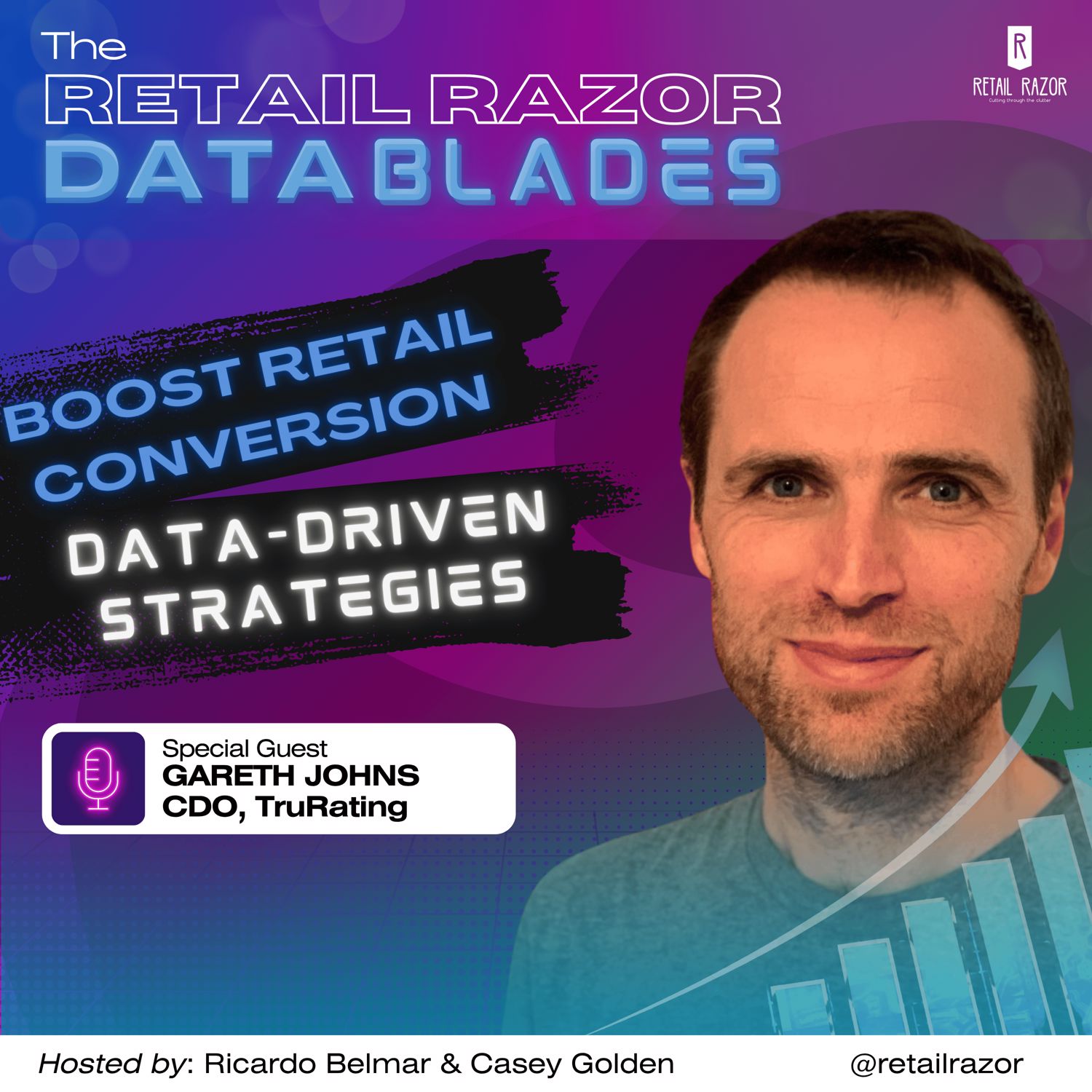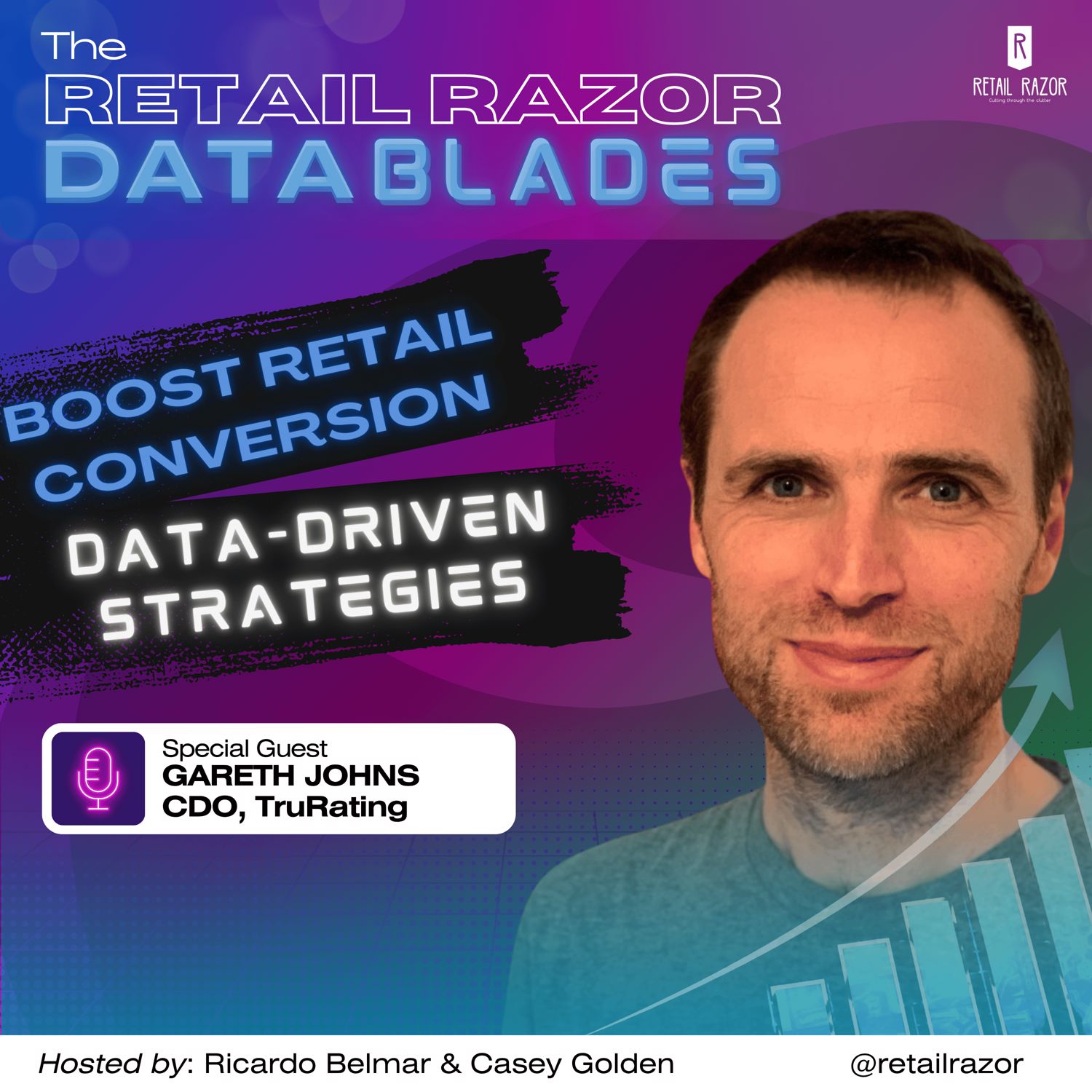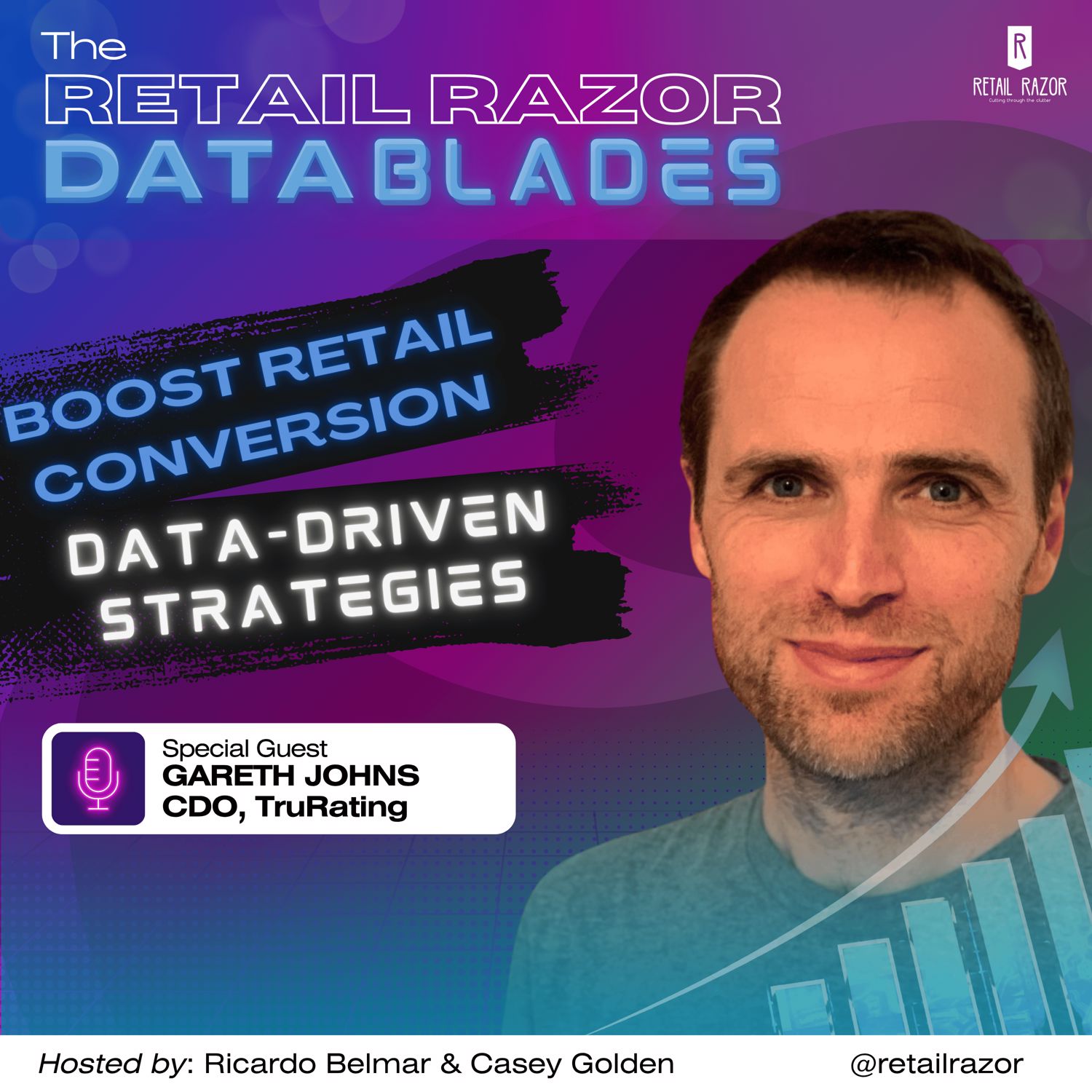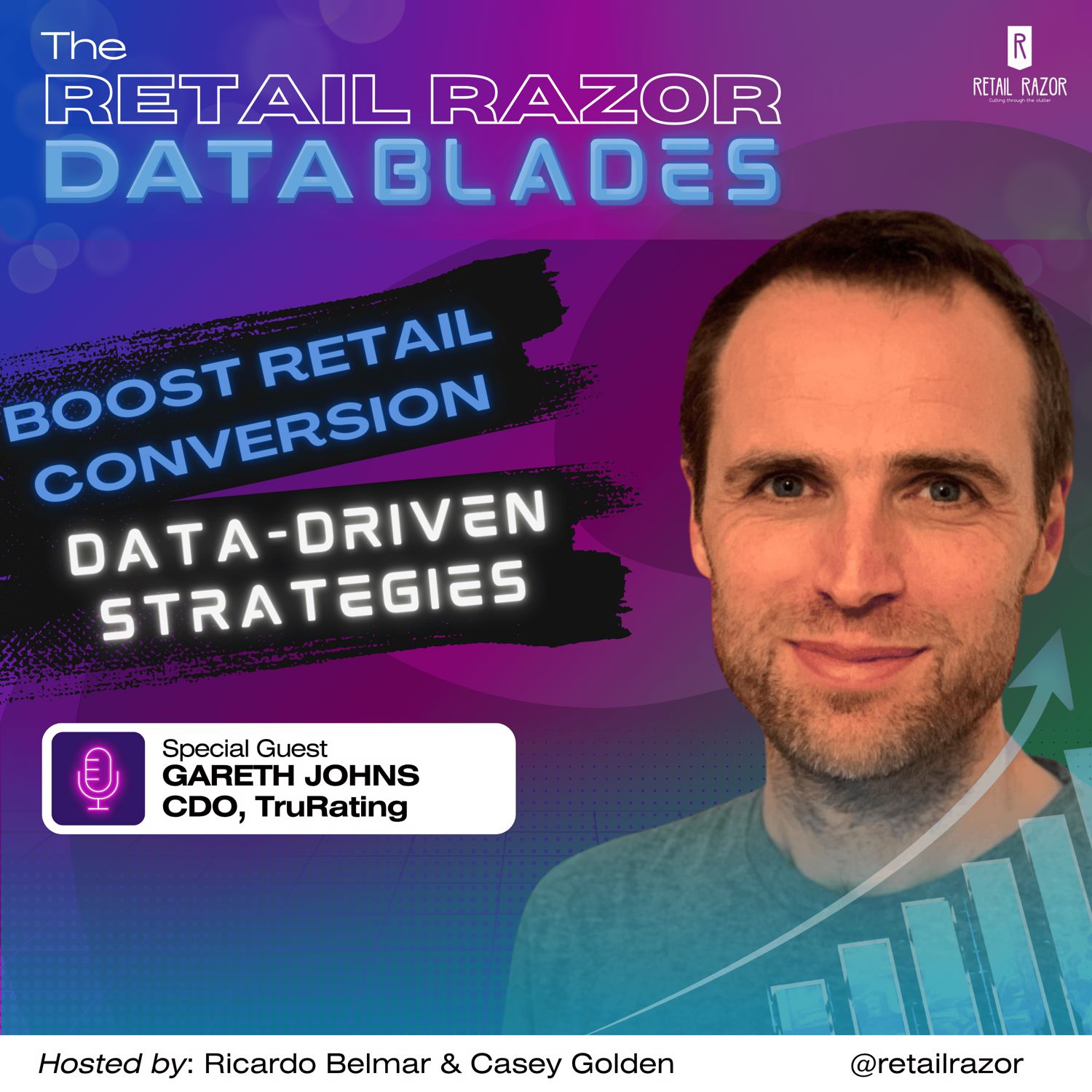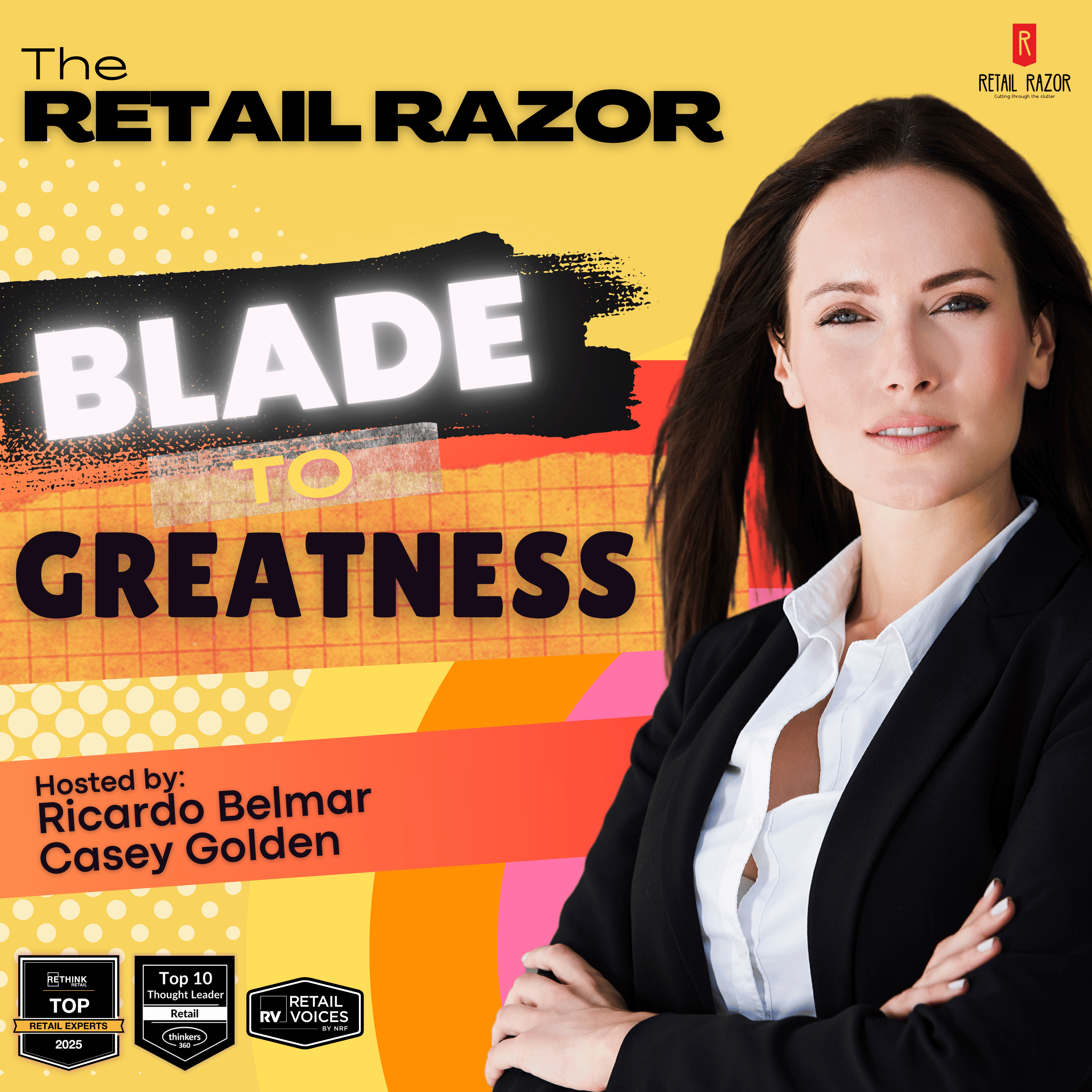01 November 2025
Boost Retail Conversion: Gareth Johns on Data-Driven Strategies That Drive Sales - S2E1

Season Two of The Retail Razor: Data Blades opens with a sharp focus on the retail metric that makes or breaks growth: conversion rates.
Hosts Ricardo Belmar and Casey Golden sit down with Gareth Johns, Chief Data Officer at TruRating, to reveal how real-time shopper feedback and data-driven insights are helping retailers unlock millions in revenue.
👉 In this episode, you’ll discover:
- Why conversion is the biggest untapped retail growth opportunity.
- The flaws in exit surveys, QR codes, and focus groups.
- How staff availability and customer expectations directly impact sales.
- A footwear case study that drove an 8% lift in conversion and unlocked $16.7M in revenue.
- Practical steps to increase in-store conversion rates and improve customer experience.
If you’re a CMO, COO, or CEO looking to optimize retail performance, this episode delivers conversion strategies you can act on today.
Subscribe to the Retail Razor Podcast Network: https://retailrazor.com
Subscribe to our Newsletter: https://retailrazor.substack.com
Subscribe to our YouTube channel: https://go.retailrazor.com/utube
Chapters:
(00:00) Preview
(00:00) Case Study: Footwear Brand Conversion Success
(00:41) Show Intro
(03:17) Welcome Gareth Johns, Chief Data Officer, TruRating
(03:57) Challenges in Measuring Conversion
(08:36) Effective Shopper Feedback Mechanisms
(13:54) Case Study: Footwear Brand Conversion Success
(18:22) Key Takeaways and Actionable Insights
(20:11) How to Learn More
(20:53) Show Close
Meet your hosts, helping you cut through the clutter in retail data insights:
Ricardo Belmar is an NRF Top Retail Voices for 2025 & a RETHINK Retail Top Retail Expert from 2021 – 2025. Thinkers 360 has named him a Top 10 Retail & AGI Thought Leader, a Top 50 Management, Transformation, & Careers Thought Leader, a Top 100 Digital Transformation & Agentic AI Thought Leader, and named him one of the Top Voices for 2024 and 2025. He is an advisory council member at George Mason University’s Center for Retail Transformation, and the Retail Cloud Alliance. He was most recently the director partner marketing for retail & consumer goods in the Americas at Microsoft.
Casey Golden, is CEO of Luxlock, a RETHINK Retail Top Retail Expert from 2023 - 2025, and a Retail Cloud Alliance advisory council member. Obsessed with the customer relationship between the brand and the consumer. After a career on the fashion and supply chain technology side of the business, now slaying franken-stacks and building retail tech! Currently, Casey is the North America Leader for Retail & Consumer Goods at CI&T.
Includes music provided by imunobeats.com, featuring Tech Lore from the album Beat Hype, written by Heston Mimms, published by Imuno.
well I think the first thing, I mean whether it's retailers or whether it's the staff, well, what I would really. Is for staff in stores to realize how big an impact they can have Like, that was the worst experience of my life. You know? There was no one to help me. I've been stood here for 20 minutes, whatever it might be. we're up to over a billion ratings now, so we've heard from lots of different people in lots of different retailers around the globe. You've gotta give them more of a, when customers are coming in buying women's footwear, they are not gonna stand around like a lemon and wait for somebody for 20 minutes.
Whereas maybe for somebody coming in buying male footwear, they, they will just stand there for a while looking around,
[00:00:39] Casey Golden:
Well, if you can't measure it, you can't grow it.
[00:00:41] Ricardo Belmar:
Right. Welcome to Season Two, Retail Leaders. This is the Retail Razor Data Blades, the podcast that slices through complex retail research to deliver sharp, actionable insights you can use today. I'm Ricardo Belmar.
[00:01:01] Casey Golden:
and I'm Casey Golden. We're kicking off season two with a topic that's top of mind for every retail executive, conversion. It's the metric that makes or breaks performance, and yet it's still one of the biggest mysteries in retail.
[00:01:15] Ricardo Belmar:
That's right. We obsess over foot traffic, dwell time and basket size. But what about the people who walk in and walk out without buying? What really stops them from converting?
[00:01:26] Casey Golden:
Today we're joined by Gareth Johns, Chief Data Officer at TruRating. To unpack the myths and the realities behind conversion rates, Gareth's team has analyzed millions of shopper responses to uncover what non shoppers won't tell you, and how listening to actual buyers can reveal the friction points that drive walkaways.
[00:01:49] Ricardo Belmar:
We'll explore why traditional methods like exit surveys, QR codes and tablet stations often miss the mark and how TruRating's, real-time feedback model flips the script by capturing sentiment at the point of sale. Gareth will also share a powerful case study from a leading footwear brand that saw an 8% lift in conversion and unlocked a 16.7 million in revenue opportunity just by acting on shopper feedback.
[00:02:13] Casey Golden:
And if you think conversion is just about pricing and promotions, think again. We'll dive into how staff availability, store layout, and even subtle customer experience cues can make all the difference.
[00:02:27] Ricardo Belmar:
So whether you're a CMO looking to optimize campaign ROI, a COO, focused on store performance, or a CEO driving strategic growth, this episode is packed with insights you won't wanna miss. Before we dive in, quick favor, if you're enjoying the show, hit us with a five star rating and drop a short review on Apple Podcasts, Spotify, Goodpods, or wherever you're listening.
[00:02:47] Casey Golden:
And don't forget to like and subscribe our YouTube channel so you don't miss an episode.
[00:02:52] Ricardo Belmar:
Plus check out the other shows in the Retail Razor Podcast Network, The Retail Razor Show, Retail Transformers, and Blade to Greatness. You'll find them all in your favorite podcast app or together on our YouTube channel.
[00:03:04] Casey Golden:
Now let's get into it. Here's our conversation with Gareth Johns, Chief Data Officer at TruRating to reveal how data backed insights are transforming conversion strategies across leading retail brands.
[00:03:24] Ricardo Belmar:
Welcome to the Retail Razor Data Blades. Gareth, it's so glad to have you here to help us launch season two, and a big thanks to you and the team at TruRating for pulling all these data insights together for this three part series we're kicking off today.
[00:03:36] Gareth Johns:
Oh, thank you for having me
[00:03:37] Casey Golden:
Gareth, we're starting this series with a super important topic. Maybe the most important topic for retailers, certainly one that we've definitely want to leverage data to make us smarter about. The topic is conversion. Tell us why conversion has been such a hot topic for retailers right now. What's driving this urgency and how have retailers traditionally approached some conversion challenges?
[00:04:04] Gareth Johns:
So I think it's a hot topic because it's probably one of the biggest opportunities to grow revenue for many types of retail. Not all types, but you know, if you ignore the kind of the grocery stores where you're obviously once you walk in the door, you're gonna buy something or the distressed purchase. Definitely for the fashion footwear specialty type retailers that we work with conversion's a big opportunity because many of them are only seeing around 15 to 20% of the customers that may be coming into that store actually purchasing something.
So there's a huge opportunity to grow revenue by cracking conversion and just put, even if you push that up a couple of percent you're really doing something there. Think that's why it's a hot topic in terms of, I guess what we're seeing from it. I think many retailers sort of ignore it. I think they, they think it's too complicated. You know, they kind of have a conversion is what it is. And there's nothing I can do that will change that kind of view, or it's just too hard to measure. And then I think maybe some others, you maybe get to the point where they say well, I can, I'm gonna do all this work to figure out how to measure it.
I'm gonna put counters on the front of my store. I'm gonna use trackers on mobile phones to, to work out what's going on. But even if you measure it that's not much of our use unless you can figure out how to change it. So, yeah, I think that's sort of a starting landscape of really what's going on in conversion for a lot of our retailers.
[00:05:24] Casey Golden:
Well, if you can't measure it, you can't grow it.
[00:05:26] Ricardo Belmar:
right. That's right. That's why the data is so important. One way we can look at it, and I know this is how you talked about this in other places before, there's sort of a distinction between your non shoppers, right? And people who you want to convert obviously into someone who buys from you. But there, I guess there's some misconceptions around what to do and how to engage these non shoppers and converting them that retailers kind of struggle with. I mean, obviously some retailers will use things like focus groups. They'll try to get people to engage via a QR code or some exit questioning from the store.
What are some of the, I wanna say stranger, weirder or ineffective ways that you've experienced retailers trying to engage with these non-shoppers, and why don't these methods work? What kind of blind spots do they leave and what have you seen with retailers you engaged with?
[00:06:13] Gareth Johns:
definitely the perfect option would be if people that came into your store that didn't end up buying anything, were willing to sit down with you at the end and explain why they didn't
[00:06:20] Ricardo Belmar:
Exactly. Yeah.
[00:06:23] Gareth Johns:
Yeah. So I, I get where everyone's, if only that's, I get where everyone comes from and, and we get that a lot with our retailers. They're saying that, but these are the people I wanna talk to. And it's just, it's so difficult because we're all consumers, right? So we all go into stores, we all have a, either a slightly off-putting experience or a slightly frustrating experience, or we were just never in the market for buying anyway. And then we walk out the store, the last thing we wanna do is then sit down with somebody and explain why we didn't purchase. So, yeah, I think a lot of the things that you've talked about there the person kind of doorstepping you as you're trying to walk out the store.
The, the QR codes asking you to leave feedback as you're leaving the store. Those all exist and we've seen them. One, I think you're gonna be very unlikely to hear from many customers if you do that. And then the customers that you do hear from, I would have little confidence, are actually representative of your main customer. It's such a, it's such an unusual thing to give feedback. The people that will give you feedback are those that have a real reason to give you feedback. Like, that was the worst experience of my life. You know?
There was no one to help me. I've been stood here for 20 minutes, whatever it might be. So you're just not gonna, I think if you go for that, if you go to that approach, you're gonna hear from the wrong people and you're gonna chase the wrong things. So I think, it would be a perfect world to tear from every single non shopper and get a representative sample and really uncover what's going on. But I think trying to tackle it in that kind of logical way of, well, I'm gonna go, I'm gonna find a way to talk to these people,
[00:07:54] Ricardo Belmar:
Mm-hmm.
[00:07:55] Gareth Johns:
I haven't seen a way that, that it works. So,
[00:07:57] Ricardo Belmar:
Yeah.
[00:07:57] Gareth Johns:
so, Yeah.
[00:07:58] Ricardo Belmar:
Yeah,
[00:07:59] Casey Golden:
Yeah, the one-on-one isn't very scalable. My, the owner of my bodega would run after me and be like, wait, wait, wait. What did you want
[00:08:09] Ricardo Belmar:
Yeah.
[00:08:10] Casey Golden:
not getting? And I turned him into the bougiest bodega on the block.
[00:08:16] Ricardo Belmar:
Yeah. Yeah. And I think it's also true, like just from a human nature point of view, you're, a consumer's more inclined to share that kind of feedback from a non purchase for negative reasons than they are for positive reasons. I'm sure most consumers mind, if it was positive, they would've bought something. So the fact that they didn't probably means there was something negative and offputting for them. So you all at TruRating, you, and, I think you have data around, how consumers feel about these things. You've probably collected, information around what are those key reasons that people decide not to convert in store.
And can you walk us through some of the shopper feedback mechanisms that you do use and you know, what kind of questions do you ask and how do consumers respond to those?
[00:08:57] Gareth Johns:
Yeah, so we ask questions predominantly not exclusively. We do have some of those other methods, but predominantly, I guess our USP is we ask questions on the pin pad when you go to pay, just before you tap your card. So it's in the moment of truth, it's a validated answer from a particular customer. And we have the ability to ask different questions, all of which are answered by the single tap of the button. So, we can ask lots of different questions and we can combine the results that we get with lots of other information about what's going on. Like, what did you buy, how busy was the store, which store was it?
Which register were you on? How many other people were in the store at the same time? How often do you come to this store? There's lots of other kind of contextual information that we can add alongside the, whatever the question is that we ask and the answer that we get. And then I'd say our questions generally fall into probably three buckets. One's kind of about the staff experience that you had. Did staff do the things that maybe you were expecting them to do? One's there's another bucket, which is really the store was the store. Did the store experience play out the way you were expecting?
And then the third is more, I guess more kind of customer intent or customer behavior. Did you know what you were gonna buy when you came in today? Which gets at the kind of browsing versus mission driven or is this store your first choice for clothing? Or first choice for shoes to really understand, is this a distressed purchase? Is this, have you, are you talking to a loyal customer here? Like tho those kinds of things as well. So we can ask lots and lots of questions. The only real limitation is the question needs to be relevant to the person that answers it and they need to be able to answer it with a single button press.
So we do a lot of multiple choice. Binary choice. Binary, yes. No type stuff. And then some scaled things, I think in terms of what we learned from that data. And, you know, we're up to over a billion ratings now, so we've heard from lots of different people in lots of different retailers around the globe. From a conversion point of view, I don't think there's anything that's massively unusual or kind of mind blowing. You know, there's the customer wasn't even in the market to purchase. They were just browsing. There's a lot of that that you kind of learn and, and that's different depending on the business that you are and the store and, and where you are.
So certain businesses just attract a more browser type customer who's only, some customers will only go to a certain store if they're pretty much ready to buy others, you're the type of, you attract a lot people, you know. You're a great place to go and just look, but people don't buy. And then I think where the store's located has a big impact as well. So you're in a shopping mall, you are gonna definitely get a lot more, movement of customers coming in and out. You're in a strip mall, that's a long way away. You've gotta drive to, you're likely to only go there if you're really in the market.
So I think that's one bit. Then there's the, I couldn't get help quick enough. We've seen that. And how that plays out depending on what you buy is interesting. Or the product wasn't available or the, or if, if the product wasn't available, staff didn't do a good enough job of offering alternative products. And then finally, I think this whole kind of concept of closing the deal at the end staff maybe are more of a service mindset where they are quite good at helping you as a customer, but they're really not doing the sales approach of, I'm gonna try and actively close this deal at the end.
So we see, I guess all those different things going on as, as reasons why people don't convert. And I, I don't think any of that to a retailer would be unusual. They're not gonna sit there and go, oh, you've, you know, you've, you've unlocked the silver bullet as to why my customers aren't converting. I think what our data allows us to do is say, how does each store do at those things? And when does the store do well at that? And when does the store not do well at that? And so if you're gonna try and change behavior so that you can change conversion, where do you need to focus?
Because it's no good just going to a store and saying, you're at 15% conversion. I'd really like you to be at 20%. Please make it happen. You've gotta give them more of a, when customers are coming in buying women's footwear, they are not gonna stand around like a lemon and wait for somebody for 20 minutes. Whereas maybe for somebody coming in buying male footwear, they, they will just stand there for a while looking around, so,
[00:13:05] Ricardo Belmar:
Right.
[00:13:06] Casey Golden:
What are you saying? We don't have patience.
[00:13:10] Gareth Johns:
we've got more things to do.
[00:13:12] Casey Golden:
six months
[00:13:13] Ricardo Belmar:
you may have higher expectations,
[00:13:17] Gareth Johns:
Yes. Which I think is an important point, right? That expectation point is
[00:13:21] Ricardo Belmar:
Yeah.
[00:13:22] Gareth Johns:
we see a lot of our retailers say, but I, I offer everybody exactly the same service. You know, like, I don't discriminate. And it's like, well, yeah, but people have, this is all what everything we capture as a company is about perception. It's the customer's perception of what's going on and customers have different perceptions, so....
[00:13:38] Casey Golden:
yeah, you can't meet expectations or exceed expectations if you don't know where the baseline is. And every consumer group has a different level of like basic expectations. I feel,
[00:13:50] Ricardo Belmar:
you have to know, you
[00:13:51] Casey Golden:
gotta really figure out how to meet them where they are.
[00:13:53] Ricardo Belmar:
Yeah. Yeah. So, Gareth, sticking with this footwear example. You've worked with a, a footwear brand where I think the data was that you saw an 8% increase in conversion that led to a, a 16.7 million in revenue opportunity. Can you tell us more about that story and what maybe some of the specific insights were that, that drove that change? Particularly, what you just mentioned about the role the store staff plays in that, and, how does that lead to the improving results?
[00:14:23] Gareth Johns:
So what we did is we worked with a footwear retailer in the US that's got a number of different stores in, in lots of different states. Their stores are located to the point I was making earlier about this strip shopping mall thing. They have got shopping mall and strip mall and the main two types of store base. And they, what we see is that conversion is very different between those two different sets of stores. The other thing that we see is that the retailer was effectively managing their rotor based on revenue. So you do this much in sales, you get these many people in the store, you do this much in sales, you get these many people in the store not.
You have these many people walk in the door to service that many people and to close that opportunity, you need these many people. So I think if you are the first point of, if you're just looking at revenue as a driver of how many people, how many staff members should I have? You see huge disparities. So what they were seeing was like some stores, a member of staff for every staff hour that there was, that they were basically putting in that store, they might have 35 customers come in, or 35 potential customers come in. Another store might only have five come in.
So it's a very different kind of customer experience that was going on. So just understanding that and being able to kind of get below an average of, you're at 20% conversion or whatever, and actually say your behavior. The setup in stores is very different, even within the same retailer was our first point. And then the second thing we looked at was of all the things that we were asking, which one had the biggest impact on conversion? So when a store had a high conversion number, what was it doing well, but another store that didn't have a high conversion number maybe wasn't doing as well.
And that really came down to staff availability was a really big issue for this one. And that's from a customer's perception point of view. That's not a, I had these many customers come in the door and I had these many staff on the floor, so my availability was definitely this. It's as a customer, did you feel that staff were attentive and available and that point of view? And so we could see that basically what we did with them is we did a test where we said. If you took some of the hours that you were investing in staff and you moved it around to try and change the, I guess, the profile, could you make staff availability better
[00:16:34] Ricardo Belmar:
Mm-hmm.
[00:16:34] Gareth Johns:
and what the test showed is Yes. You, you could, you could definitely get it to payback. It would have a positive ROI, it wouldn't be the most amazing ROI. There are probably other places you could invest that money. That in itself wasn't really the key point of what we learned. What we actually learned was two stores that had the same number of staff per number of customers coming in, had very different perceptions of staff availability. So it wasn't so much throw money at the problem and this will go away. It was more you have to crack the behaviors first before you put more money into this.
And actually what they did is they just plotted every single store and they would have whole set of stores that were roughly similar in terms of they're all in a similar type of environment. Strip mall versus shopping center. They all have a similar number of potential customers walking in the store each hour for a number of staff hours. And yet perceptions of availability of staff were 14, 15% different between best and worst. So they could just then focus on those at the bottom and say, you guys are doing something incorrect. You're either, you're either giving people tasks to do when they should be out serving customers, or you've just employed people that just really don't wanna deal with customers or, you know, whatever it might be.
And really just by focusing in on the stores that were at the bottom, over the course of a kind of a three month period, they were able to reduce that gap between best and worst stores over. That leads to better overall availability of staff leads to better conversion. And I think for a lot of what we do, that's kind of where we, where we end up is comparable results between stores that can be compared and it just pinpoints where you need to focus.
[00:18:14] Casey Golden:
Well, I always love conversion conversations. Coming back to people and staff training,
[00:18:19] Ricardo Belmar:
Exactly. So important.
[00:18:23] Casey Golden:
what's the one thing you wish more retailers understood about conversion? And how can someone get started with a more effective conversion strategy, let's say next week.
[00:18:33] Gareth Johns:
Well I think the first thing, I mean whether it's retailers or whether it's the staff, well, what I would really. Is for staff in stores to realize how big an impact they can have
[00:18:42] Ricardo Belmar:
Hmm. Right.
[00:18:44] Gareth Johns:
And I think that is underplayed and they don't give themselves the credit of how much of an impact they can have. And maybe that's 'cause they, the management in that retailer don't give them enough credit or don't tell them enough, or they just don't have the data to prove it to them and back it up. But I, yeah, what I'd really want staff to know is that they are the front face of that brand and for everything else that goes on, they're the thing that have they have a bigger, a big opportunity to really impact on revenue. In terms of what retailers could do more, based on knowing that, I'd I'd say probably spend less time worrying about what is the reason my conversion is low because everything that we've done there's not been anything where I think any of us have been surprised as to what customers are after.
I think if you can focus on those five or six things that can impact on conversion and you know, anybody that's a consumer can think of opportunities where that's what are the reasons why I sometimes go into a store and end up getting annoyed and not buying stuff. It's can you measure effectively how you're doing on those things? And can you start to improve those things? And I think focusing much more on the action and less on the complicated insight or clever technical methods
[00:19:54] Ricardo Belmar:
Mm-hmm.
[00:19:54] Gareth Johns:
measuring conversion would be my
[00:19:57] Ricardo Belmar:
Mm-hmm.
[00:19:57] Gareth Johns:
actually where I'd say if you're gonna do one thing, focus on the action. Not so much the, I've done a really clever regression in our syetem and I've got lots data.
[00:20:06] Ricardo Belmar:
Yeah. It's all about the execution.
[00:20:09] Gareth Johns:
Exactly.
[00:20:09] Ricardo Belmar:
Exactly. Exactly. Well, Gareth, this has been a great discussion on conversion in so many impactful insights you've shared. You know, based on all the data TruRating's captured over these years from consumers across so many brands, how can listeners and viewers learn more about TruRating's approach?
[00:20:25] Gareth Johns:
Well, there's hopefully lots of webinars out there where I've been talking now and, and TruRating obviously at our website is always ready to chat to any retailers about what we do and we've got lots of clients who are also willing to talk about how they use us as well, so defintiely reach out through TruRating.com.
[00:20:42] Casey Golden:
Thank you Gareth. Again, thank you so much for joining us today, Ricardo. I'd say this is a wrap for episode one of our new Season Two of Data Blades.
[00:20:52] Ricardo Belmar:
Yes, it is.
[00:21:00] Casey Golden:
If you enjoyed today's episode, please give us a five star rating and review on Apple Podcasts, Spotify, or Goodpods. And don't forget to hit subscribe on your favorite podcast app or on YouTube so you never miss an episode. I'm Casey Golden.
[00:21:15] Ricardo Belmar:
We'd love to hear from you. Follow us and share your feedback at Retail Razor on LinkedIn, Bluesky, Threads, and Instagram. You can also subscribe to our Substack newsletter for highlights from every episode, and visit retailrazor.com for transcripts and more details about our guests. Data Blades is part of the Retail Razor Podcast Network. I'm Ricardo Belmar.
[00:21:37] Casey Golden:
Thanks for joining us.
[00:21:38] Ricardo Belmar:
Until next time, Stay sharp, Be data-driven, and Harness AI. This is the Retail Razor Data Blades.
